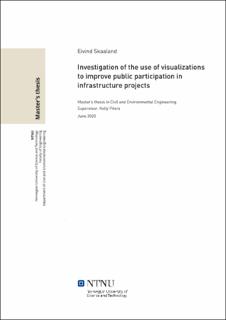| dc.description.abstract | Utviklingen av Bygningsinformasjonsmodeller (BIM) og Geografiske Informasjonssystemer (GIS) har muliggjort nye metoder for visuell kommunikasjon til bruk i planleggingen av våre fysiske omgivelser. Bruk av digitale visualiseringsmodeller i kommunikasjon med allmennheten er blitt foreslått som et middel for å komme over barrierene som hindrer gode medvirkningsprosesser. Selv om evaluering av visualiseringer er blitt gjort i årtier innen fagfeltene arkitektur, landskapsarkitektur og miljøteknikk, er det en svakere tradisjon for slik evaluering innen planleggingsprosesser i infrastrukturprosjekter.
Formålet med studien har vært å innhente informasjon om bruken og evalueringen av visualiseringer i infrastrukturprosjekter. Slik kunnskap kan bidra til bedre medvirkningsprosesser i infrastrukturprosjekter. Ulike visualiseringsmetoder er blitt sammenlignet for å fastslå om de bidro til ulik forståelse og engasjement blant allmennheten i medvirkningsprosesser. En landsdekkende undersøkelse blant arbeidstakere i infrastrukturbransjen ble brukt som hovedmetode for å innhente data innenfor forskningstemaet.
Ved bruk av Wilcoxon Signed-Rank-test ble det funnet at digitale visualiseringsmodeller fører til en statistisk signifikant bedre forståelse og økt engasjement sammenlignet med tradisjonelle visualiseringsmodeller. 3D-modeller ble også vurdert til å føre til bedre forståelse og økt engasjement sammenlignet med VR/AR-modeller, men denne forskjellen var kun statistisk signifikant for ett av fire relaterte spørsmål. Videre kom det frem av undersøkelsen at tradisjonelle visualiseringsmodeller ble mest brukt generelt i infrastrukturprosjekter, og mer konkret i kommunikasjon med offentligheten. VR- og AR-modeller ble sjeldent brukt i infrastrukturprosjekter og mange av respondentene var ikke kjent med disse visualiseringsmetodene. Videre ble det funnet at evalueringen av visualiseringer i hovedsak skjer internt, uformelt og udokumentert.
To tiltak er foreslått som et bidrag til bedre medvirkning i infrastrukturprosjekter. Første tiltak er at ettersom digitale visualiseringer bidrar til bedre forståelse og mer engasjement blant offentligheten, så bør bruken av slike visualiseringer økes. Videre bør en mer hyppig, formell og strukturert evaluering av visualiseringene gjennomføres slik at man sikrer at visualiseringene som blir brukt fører til oppnåelse av målene for det enkelte prosjekt. | |
| dc.description.abstract | The advancement in Building Information Models (BIM) and Geographical Information Systems (GIS) has enabled new ways of visual communication used while planning our physical environment. Using digital visualization models in communication with the public have been suggested as a way of overcoming barriers hindering well implemented public participation. While evaluating visualizations has been done for decades within the disciplines of architecture, landscape architecture, and environmental engineering, it is less explored within infrastructure planning processes.
The research objective of the study was to gain information on the use and evaluation of visualizations in order to improve public participation in infrastructure planning processes. Different visualization models were compared in order to determine if the visualizations led to differences in understanding and engagement among the public in the planning process. A national survey among professional practitioners in the Norwegian infrastructure industry was used as a main method to gather data on the research issue.
Using Wilcoxon Signed-Rank Test, it was found that digital visualization models led to a statistically significant increase in both understanding and engagement, compared to traditional visualization models. It was rated that 3D models led to better understanding and increased engagement compared to VR/AR models. However, the difference was only statistically significant for one out of four sub-questions regarding understanding and engagement. It was also found that traditional visualization models were most commonly used in infrastructure projects in general, but also in communication with stakeholders and the public. VR and AR models were seldom used in infrastructure projects and many of the respondents were not familiar with these visualizations. Regarding evaluation, the most common way of evaluating visualizations were internally, informally, and undocumented.
Two aspects are suggested as a contribution to better public participation in infrastructure projects. First, as digital visualizations were reported to lead to the best understanding and most engagement among the public, an increase in use of these visualizations could be beneficial. Second, a more frequent, formal, and structural evaluation of visualization should be done in order to ensure that the visualizations used, to a greater extent, meets specific project objectives. | |
